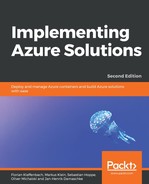Azure has some vocabulary that we will need to define at first:

The Azure scaffold that you can see in the preceding diagram easily summarizes the components Azure itself relies on. Beyond this, we need a plan for departments, accounts, and subscriptions:
- Department: This is the same as the department you know from a company's organizational chart
- Account: This is a credential that has access to the Azure tenant portal
- Subscription: This in Azure is the root of all resources and defines the limits of them to be deployed at their maximum (for example, cores, RAM, or storage):

The preceding diagram clarifies the relationship between those components. In general, there are three models available on which you can plan your hierarchy:
- Functional approach: The functional approach defines the hierarchy based on the departments of a company, which is generally quite easy to define:

Image source: https://azure.microsoft.com/en-us/blog/organizing-subscriptions-and-resource-groups-within-the-enterprise/
- Business unit approach: This approach defines the hierarchy based on a company's business units:

Image source: https://azure.microsoft.com/en-us/blog/organizing-subscriptions-and-resource-groups-within-the-enterprise/
- Geographic approach: The geographic approach defines the hierarchy based on geographical regions:

Image source: https://azure.microsoft.com/en-us/blog/organizing-subscriptions-and-resource-groups-within-the-enterprise/
The hierarchy approach is the basis for all subscription design and planning.
